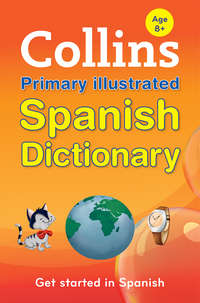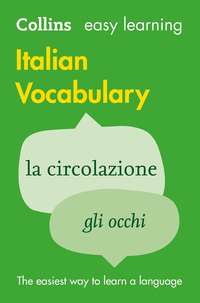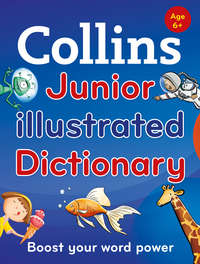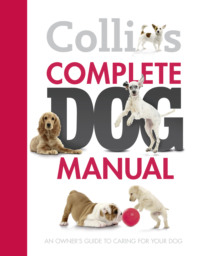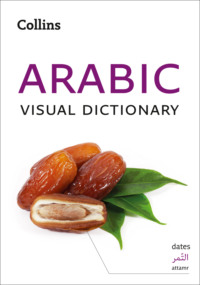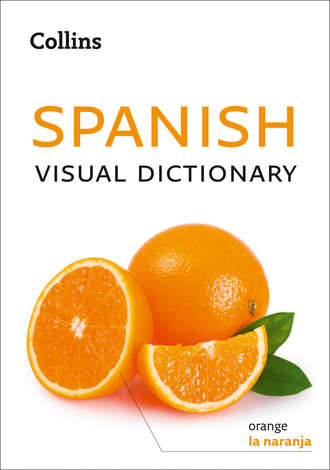
Полная версия
Collins Spanish Visual Dictionary
el vendedor / la vendedora
scientist
el científico / la científica
secondary school teacher
el profesor / la profesora
soldier
el soldado / la soldado
vet
el veterinario / la veterinaria
waiter
el camarero
waitress
la camarera
I work at/in…
Trabajo en…
business
el negocio
company
la empresa
construction site
la obra
factory
la fábrica
government
el gobierno
hospital
el hospital
hotel
el hotel
office
la oficina
restaurant
el restaurante
school
el colegio
shop
la tienda

TIME | LA HORA
morning
la mañana
afternoon
la tarde
evening
la noche
night
la noche
midday
el mediodía
midnight
la medianoche
today
hoy
tonight
esta noche
tomorrow
mañana
yesterday
ayer
What time is it?
¿Qué hora es?
It’s nine o’clock.
Son las nueve.
It’s ten past nine.
Son las nueve y diez.
It’s quarter past nine.
Son las nueve y cuarto.
It’s half past nine.
Son las nueve y media.
It’s 20 to ten.
Son las diez menos veinte.
It’s quarter to ten.
Son las diez menos cuarto.
It’s 10 a.m.
Son las diez (de la mañana).
It’s 5 p.m.
Son las cinco (de la tarde).
It’s 17:30.
Son las diecisiete treinta.
When…?
¿Cuándo…?
… in 60 seconds/two minutes.
… dentro de 60 segundos / dos minutos.
… in an hour/quarter of an hour.
… dentro de una hora / un cuarto de hora.
… in half an hour.
… dentro de media hora.
early
temprano
late
tarde
soon
pronto
later
más tarde
now
ahora
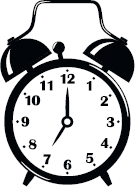
YOU SHOULD KNOW…
Spaniards tend to think about the time of day slightly differently to the British. “La mañana” (morning) could be anything up till around 1 p.m., and lunchtime (around 1.30-3.00 p.m.) is called “mediodía” (midday). “La tarde” can encompass both afternoon and evening (roughly between 3-8 p.m.).
DAYS, MONTHS, AND SEASONS | LOS DÍAS, LOS MESES Y LAS ESTACIONES
Monday
el lunes
Tuesday
el martes
Wednesday
el miércoles
Thursday
el jueves
Friday
el viernes
Saturday
el sábado
Sunday
el domingo

January
enero
February
febrero
March
marzo
April
abril
May
mayo
June
junio
July
julio
August
agosto
September
septiembre
October
octubre
November
noviembre
December
diciembre
day
el día
weekend
el fin de semana
week
la semana
fortnight
la quincena
month
el mes
year
el año
decade
la década
daily
diario
weekly
semanal
fortnightly
quincenal
monthly
mensual
yearly
anual
on Mondays
los lunes
every Sunday
todos los domingos
last Thursday
el jueves pasado
next Friday
el próximo viernes
the week before/after
la semana anterior / después
in February
en febrero
in 2019
en 2019
in the ’80s
en la década de los ochenta
spring
la primavera
summer
el verano
autumn
la otoño
winter
el invierno
in spring/winter
en primavera / invierno
THE WEATHER | EL TIEMPO
How’s the weather?
¿Qué tiempo hace?
What’s the forecast for today/tomorrow?
¿Cuál es el pronóstico del tiempo para hoy / mañana?
How warm/cold is it?
¿Hace calor / frío?
Is it going to rain?
¿Va a llover?
What a lovely day!
¡Qué tiempo tan bueno!
What awful weather!
¡Qué tiempo tan horrible!
It’s sunny/windy.
Hace sol / viento.
It’s warm/hot.
Hace calorcito / calor.
It’s cloudy.
Está nublado.
It’s misty/foggy.
Hay neblina / niebla.
It’s freezing.
Hace mucho frío.
It’s raining.
Llueve.
It’s wet.
Está lluvioso.
It’s snowing.
Nieva.
It’s humid.
Hay mucha humedad.
It’s stormy.
Hay tormenta.
It’s changeable.
Está muy variable.
nice
bueno
horrible
malo
cool
fresco
mild
suave
temperature
la temperatura
sun
el sol
rain
la lluvia
snow
la nieve
hail
el granizo
wind
el viento
gale
el vendaval
mist
la neblina
fog
la niebla
thunder
el trueno
lightning
el relámpago
thunderstorm
la tormenta
cloud
la nube

NUMBERS | LOS NÚMEROS
1 uno
2 dos
3 tres
4 cuatro
5 cinco
6 seis
7 siete
8 ocho
9 nueve
10 diez
11 once
12 doce
13 trece
14 catorce
15 quince
16 dieciséis
17 diecisiete
18 dieciocho
19 diecinueve
20 veinte
30 treinta
40 cuarenta
50 cincuenta
60 sesenta
70 setenta
80 ochenta
90 noventa
100 cien
1000 mil
1000000 millón
TRANSPORT | LOS MEDIOS DE TRANSPORTE
Travelling to Spain from the UK is easier than ever before, with many regular flights to numerous Spanish destinations. The same can be said of travelling around Spain - there is a good railway system (it can be quicker to travel by train than by plane between certain cities). The country is well connected by road, and local public transport is widely developed with good tram, bus, and metro systems in larger cities such as Madrid and Barcelona.
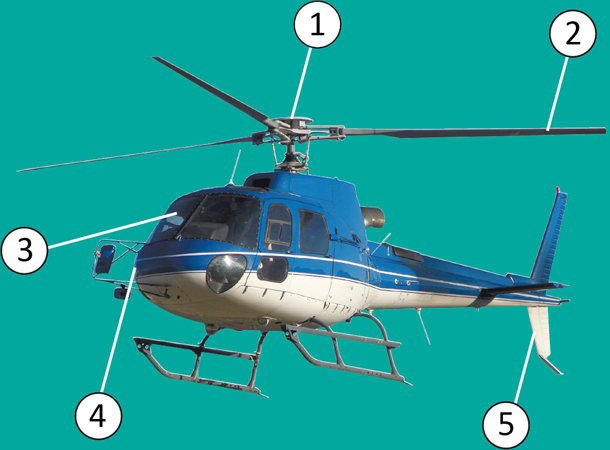
helicopter
el helicóptero
1. rotor
el rotor
2. blade
la paleta
3. cockpit
la cabina del piloto
4. nose
el morro
5. tail
la cola
THE BASICS | LO ESENCIAL
When asking for directions, it’s easiest simply to state your destination, followed by “por favor”. It’s always most polite to use “Señor” or “Señora” to address any passers-by you stop and ask.
YOU MIGHT SAY…
Excuse me…
Perdone…
Where is…?
¿Dónde está…?
Which way is…?
¿Cómo se va a / al / a la…?
What’s the quickest way to…?
¿Cuál es el camino más rápido para…?
How far away is it?
¿A qué distancia está?
Is it far from here?
¿Está lejos de aquí?
I’m lost.
Estoy perdido.
I’m looking for…
Busco…
I’m going…
Voy…
Can I walk there?
¿Puedo ir hasta allí a pie?
I’d like a taxi to…
Quería un taxi a…
YOU MIGHT HEAR…
It’s over there.
Está ahí.
It’s in the other direction.
Está en la otra dirección.
It’s … metres/minutes from here.
Está a … metros / minutos de aquí.
Go straight ahead.
Siga todo recto.
Turn left/right.
Gire a la izquierda / derecha.
It’s next to…
Está junto a…
It’s opposite…
Está frente a…
It’s near to…
Está cerca de…
Follow the signs for…
Siga las señales para…
VOCABULARY
street
la calle
driver
el conductor / la conductora
passenger
el pasajero / la pasajera
pedestrian
el peatón / la peatona
traffic
el tráfico
traffic jam
el embotellamiento
rush hour
la hora punta
public transport
el transporte público
taxi
el taxi
taxi rank
la parada de taxis
season ticket
el abono de transporte
travel card
la tarjeta de transporte
directions
las señas
GPS
el GPS
mapping app
la aplicación de mapas
road sign
la señal de carretera
route
la ruta
special assistance
la asistencia
to walk
caminar
to drive
conducir
to return
regresar
to cross
cruzar
to turn
girar
YOU SHOULD KNOW…
Season tickets (“el abono de transporte”) that can be used across different forms of public transport are very commonly used in metropolitan areas in Spain.
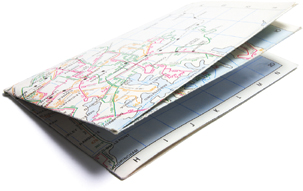
map
el mapa
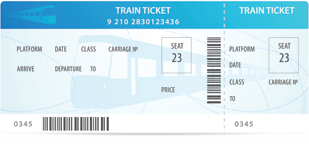
ticket
el billete

timetable
el horario
CAR | EL COCHE
Traffic drives on the right-hand side in Spain. Remember to carry your ID, driving licence, proof of insurance, and car registration documents with you while driving in Spain.
YOU MIGHT SAY…
Is this the road to…?
¿Es esta la carretera a…?
Can I park here?
¿Puedo aparcar aquí?
Do I have to pay to park?
¿Tengo que pagar por aparcar?
Where can I hire a car?
¿Dónde puedo alquilar un coche?
I’d like to hire a car…
Quería alquilar un coche…
… for four days/a week.
… para cuatro días / una semana.
What is your daily rate?
¿Cuál es el precio por día?
When/Where must I return it?
¿Cuándo / Dónde debo devolverlo?
Where is the nearest petrol station?
¿Dónde está la gasolinera más cercana?
I’ve put in … litres/euros of petrol.
He puesto … litros / euros de gasolina.
YOU MIGHT HEAR…
You can/can’t park here.
Puede / No puede aparcar aquí.
It’s free to park here.
El aparcamiento es gratuito aquí.
It costs … to park here.
Aparcar aquí cuesta…
Car hire is … per day/week.
El alquiler del coche es … por día / por semana.
May I see your documents, please?
¿Puedo ver sus documentos, por favor?
Please return it to…
Por favor, devuélvalo en…
Please return the car with a full tank of fuel.
Por favor, devuelva el coche con el depósito lleno.
Which pump are you at?
¿En qué surtidor está aparcado?
VOCABULARY
people carrier
el monovolumen
motorhome
la autocaravana
caravan
la caravana
passenger seat
el asiento del copiloto
driver’s seat
el asiento del conductor
back seat
el asiento trasero
child seat
la silla infantil
roof rack
la baca
sunroof
el techo solar
automatic
automático
electric
eléctrico
hybrid
híbrido
engine
el motor
battery
la batería
brake
el freno
accelerator
el acelerador
air conditioning
el aire acondicionado
clutch
el embrague
cruise control
el control de crucero
exhaust (pipe)
el tubo de escape
fuel tank
el depósito de gasolina
gearbox
la caja de cambios
transmission
la trasmisión
Breathalyser®
el alcoholímetro
to start the engine
poner el motor en marcha
to brake
frenar
to overtake
adelantar
to park
aparcar
to reverse
dar marcha atrás
to slow down
aminorar la velocidad
to speed
conducir a exceso de velocidad
to stop
parar
YOU SHOULD KNOW…
Radar warning systems that have been built into sat navs can be used in Spain. However, devices that can physically detect or interfere with speed cameras are illegal.
EXTERIOR
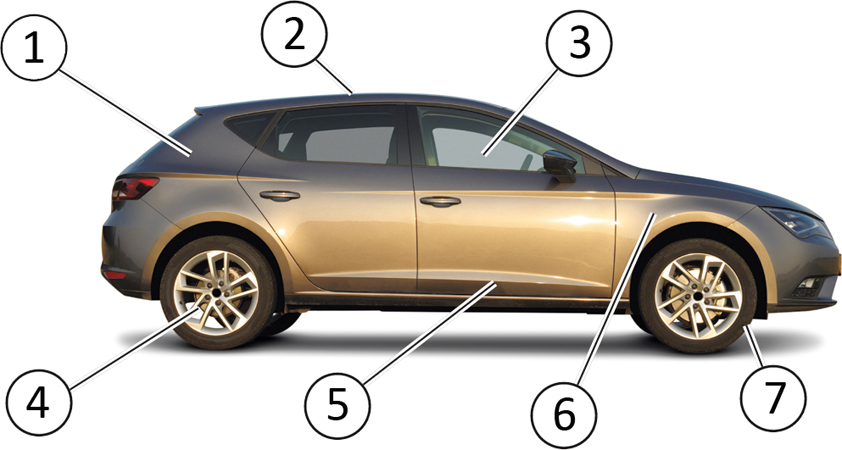
1. boot
el maletero
2. roof
el techo
3. window
la ventanilla
4. wheel
la rueda
5. door
la puerta
6. wing
la aleta
7. tyre
el neumático
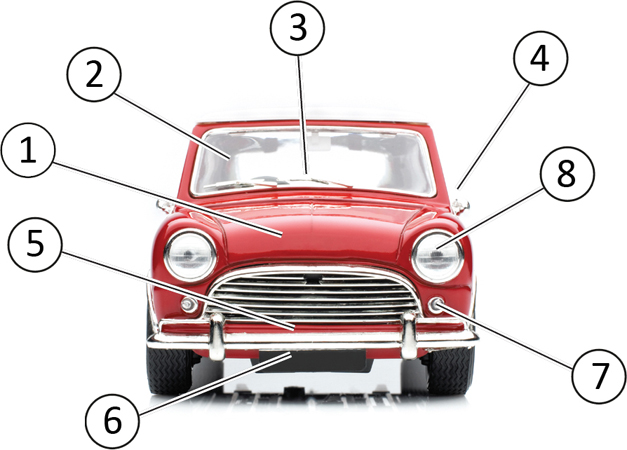
1. bonnet




